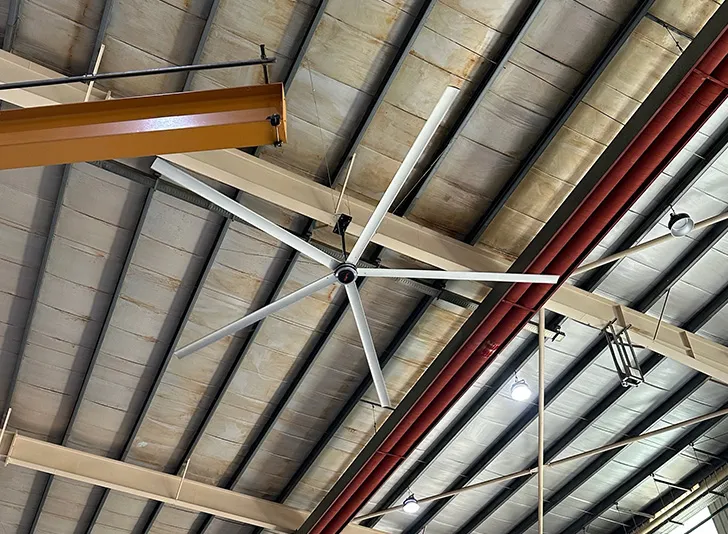When a single ventilateur de plafond struggles beneath an plafond industriel, poor flux d'air drives up coûts énergétiques and drives down productivity.
Industrial HVLS ceiling fans are oversized, low-speed, volume élevé units that move an impressive quantité d'air—often hundreds of thousands of cubic feet per minute—across very grands espaces while using surprisingly little power. They replace clusters of small room fans, réduire Consommation d'énergie, and keep workers comfortable all year.

Industrial HVLS ceiling fan for warehouse ventilation
High-Volume-Low-Speed (Système de levage à grande vitesse) technology relies on wide pales de ventilateur—often with extruded aluminum blades—rotating at fewer than 100 rpm. That low-speed sweep creates a towering column of mouvement de l'air that spreads out in a 360° pattern, forcing cool air down and pushing warm air toward vents. One single hvls unit can replace a dozen box fans in espaces industriels.
By moving so much air the fan quickly equalizes temperature, cuts humidity, and produces débit d'air maximal without drafts. A grand ventilateur like our 7.3 m (24 ft) model covers up to 2 000 m² (over 20 000 superficie en pieds carrés), moving more than 300 000 pieds cubes per minute (cfm). That’s true volume élevé performance at faible vitesse.
Factory floors, aircraft hangars, and sports halls are classic large room environments. Because hot air stratifies above the working zone, employees feel stuffy while heaters work overtime. Ventilateurs de plafond industriels break that thermal layer so everybody in great rooms feels the same temperature—no cold shoulders, no sweaty corners.
Grands ventilateurs de plafond are rated by cfm—the quantité d'air they displace. A 4.3 m (14 ft) fan typically delivers 150 000 cfm, while a 7.3 m (24 ft) unit exceeds 300 000 cfm. That’s 25× the capacity of a 56 cm pedestal powerful fan and equals the airflow of a small rooftop blower—yet draws less than 1 kW.
| Diameter (ft) | Typical CFM | Coverage (m²) |
|---|---|---|
| 14 | 150 000 | 900 |
| 18 | 200 000 | 1 200 |
| 24 | 300 000 | 2 000 |
Un économe en énergie HVLS unit destratifies air chaud in winter, allowing the thermostat to drop 3–5 °C and producing des économies d'énergie significatives. In summer the same fan boosts circulation d'air, letting you raise set-points while workers still stay cool and comfortable. Independent studies show up to 6 % less Consommation d'énergie for every reduced degree of set-point.
“After installing eight units in our 10 000 m² logistics hub, heating bills fell 28 %.” — Facility Manager, Osaka
Many buyers think “bigger is better,” but the finding the best match starts with ceiling height. In mezzanines a 6 feet diameter unit may suffice; in 12 m-high distribution centers you’ll want seven feet or larger. Always confirm clearance, joist load, and industrial building codes before purchase.
Need help? Our ventilateurs de plafond industriels pour la fabrication guide breaks it down step by step.
Grande vitesse room fans spin fast, deliver spot cooling, but create noise and drafts. An HVLS ventilateur hvls runs at à faible vitesse, yet the blade span multiplies coverage for true powerful cooling. Testing shows loggers record 4 °C effective temperature drop under HVLS, compared with 1.5 °C under small grande vitesse units. Fewer motors also mean lower maintenance and quieter shifts.

Which Delivers Maximum Airflow
Yes. The sheer diameter creates airflow at sound levels below 50 dB—quieter than normal office chatter. That’s thanks to faible bruit profiles, aerodynamic hubs, and vibration-free mounts. The grande industrie design means no screaming belts, so the Le ventilateur fournit comfort without disrupting meetings or machine-operator communication.
Our latest smart ceiling range connects via Modbus or BACnet, works with Google Home, and supports app-based remote control. A built-in inverter lets the ceiling fan w variable-speed drive sync with your système CVC for seamless contrôle climatique. Facilities using a smart home dashboard gain real-time kWh metrics and adaptive scheduling via group remotes.
Notre entrepôt Ventilateurs HVLS page offers a downloadable inspection sheet for commercial ou industriel projects.

Installation & Maintenance Guide
When managers search “fans products or buy online” or drive to Home Depot, they often compare specs blindly. Instead, evaluate:
Browse best HVLS fans or see custom options for espaces commerciaux like arenas in our commercial ceiling fans for sports centers. We also host live demos at our fan offers events.
A typical 52 inch residential unit moves about 7 000 cfm; a hvls industrial fan moves 150 000 cfm or more and is engineered for duty cycles exceeding 50 000 hours.
No. Our low-profile led light modules sit inside the hub and do not disrupt aerodynamics.
Yes. Native BACnet lets the fan talk to your CVC BMS, adjusting speed as ducts cool or heat load changes.
Absolutely. Reverse mode pushes down stratified air chaud, leading to des économies d'énergie significatives on heating.
Aluminum offers lighter mass and better rigidity, letting the fan hit volume élevé targets with less torque.
Stay productive, safe, and comfortable—upgrade to an Industrial HVLS Ceiling Fan today.


Salut, je suis Michael Danielsson, PDG de Vindus Fans, avec plus de 15 ans d'expérience dans le secteur de l'ingénierie et de la conception. Je suis ici pour partager ce que j'ai appris. Si vous avez des questions, n'hésitez pas à me contacter à tout moment. Grandissons ensemble !